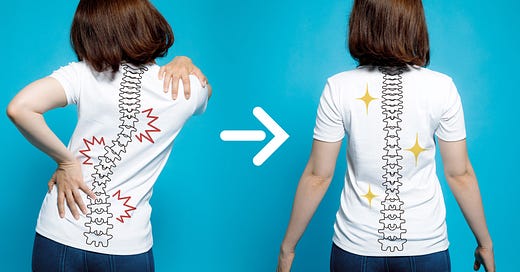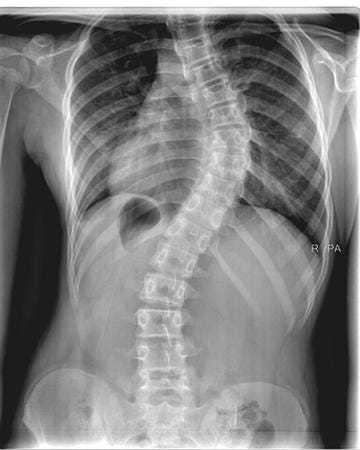If you’re anything like me, there are days in practice, and patients that you meet, who will stay with you forever and have a profound impact on you.
One of those people for me is a lovely girl, who was 7 years old when we met.
She was visiting the UK from Australia with her family and had booked in at the scoliosis clinic I worked at for an opinion on her condition.
Her parents explained that she had Juvenile Idiopathic Scoliosis and had undergone her first spinal surgery at age 4. She had growth rods fitted at this point to try to control her spinal curvature as she grew. Her body rejected the hardware and the surgeons had to re-operate to fit them again.
Unfortunately, her body rejected them again. So, by the time I saw her at age 7, she had already been told there was nothing more surgery could do for her, leaving her parents desperately looking around for other alternatives.
Working purely in scoliosis for several years, with people of all ages, gave me exposure to a wide range of opinions on surgery and hooked me into the debate of whether we ‘should’ be operating, and what the evidence base for the necessity of surgery actually is.
Obviously the above is an extreme example. Most scoliosis operations in the UK are performed on teenagers and young adults.
The current ‘standard’ scoliosis operation in the UK involves a long incision down the back, removal of the facet joints through a significant portion of the spine, the insertion of screws into the pedicles which are then used to manually move the spine back towards the midline. 2 metal rods are then inserted through the screws to hold the spine in place. Finally the facet joints which have been removed are ground into a ‘paste’ and mixed with bone graft substance before being put back in along the spine to hopefully achieve spinal fusion.
All in all, a big procedure which carries all the risks of major surgery. At the time of writing there is a documentary series available on BBC iPlayer called Surgeons at the Edge of Life. In Season 5, episode 5 a teenage boy’s scoliosis surgery is well depicted and I highly recommend all MSK clinicians watch it. [1]
So, what is so dangerous about living with idiopathic scoliosis that warrants such an invasive procedure on children and teenagers?
Part of the challenge in answering this question is that a lot of the scoliosis research is understandably of low quality, given that it is a condition with so much variability and confounding factors and requires long term follow up.
In 1968, two long term studies of scoliosis were published which went on to influence beliefs and treatments approaches for decades. Unfortunately these studies had significant limitations, as they included idiopathic scoliosis (spinal curvature of unknown origin) along with scoliosis with known causes/other etiologies. These studies concluded that people with scoliosis had a lower life expectancy, a risk of heart and lung issues and a greater chance of disability later in life. As such, it seemed reasonable that surgery to keep the curvature as mild as possible might be warranted [2].
However, more recent research studying only idiopathic scoliosis has shown no significant variation in life expectancy. The only health factors correlated with having a significant scoliotic curve are an increased risk of back pain and an increased risk of shortness of breath [2,3].
So, if back pain and shortness of breath are our main concerns, are these sufficient to warrant surgery or could we offer scoliosis specific physiotherapy as a viable alternative?
To understand why people with thoracic scoliosis end up with shortness of breath we need to look at what’s happening to the thorax.
Shortness of breath from scoliosis usually occurs in people with a thoracic apex to their scoliosis.
As the thoracic spine curves laterally (convex to the right in 90% of cases), the vertebrae also rotate which brings the rib cage around into a rotated position. The ribs in the concavity of the curvature are compressed and closer together.
If you assess the patient’s breathing you’ll usually find reduced rib cage movements on the concave side of the curve. This leads to a feeling of breathlessness, often leading to a mis-diagnosis of asthma. You may hear in your practice that the child/parent reports that they’re generally a fit active child but seem to get out of breath more easily than they should on exertion.
Fortunately, respiratory function is something fairly easily improved with scoliosis specific physiotherapy and re-education of breathing patterns and exercises [4].
So, that leaves us with the issue of back pain.
When younger people with idiopathic scoliosis report pain, in my experience, it is usually due to muscle imbalances throughout the back, where the musculature over the convex side of the curvature is in a slightly stretched or elongated position and the muscles in the concavities are getting short and tight. Again, scoliosis specific physiotherapy has been shown to be effective in reducing back pain and increasing activity levels and quality of life [4, 5].
At the moment, surgery is recommended in the UK for curvatures above 50 degrees of Cobb Angle. This is usually the only factor taken into consideration when the decision for surgery is made as the current evidence suggests that curvatures which are 50 degrees and above at skeletal maturity progress very slowly each year if untreated [6].
However, wind back 17 years when I first started working in scoliosis rehab and this threshold was set at 40 degrees. Now, surgeons in Europe (and some in the UK) are pushing the threshold to 60 degrees as the research points more towards idiopathic scoliosis being a benign condition from an organic health perspective.
However, there are a couple of issues with using Cobb Angle as the determining factor which I think we, as MSK therapists, need to question in principle:
Inter-rater reliability of Cobb Angle is generally poor in real world practice due to the variability in how the measurement is taken. For example, I am currently rehabbing a teenager who sought a private consultation for surgical opinion and was told his cobb angle was 54 degrees and he needed to book for surgery. He then saw his NHS consultant who was told his curve is 42 degrees and he doesn’t need surgery. These measurements were taken from the same X-ray and the discrepancy could have life changing consequences!
I don’t believe that reducing people to a number on an xray in order to make a clinical decision is wise, or good clinical reasoning. If I add in some more information about the teenager above - he’s also very fit and healthy, has no underlying health conditions, is on track to be a high level basketball player and his symptoms and breathing are already well controlled with conservative care. If we look at the wider picture of his health and lifestyle, is major spinal surgery the best route forwards?
Whilst the research around idiopathic scoliosis is generally of lower quality, most of it does suggest that a greater Cobb Angle does not correlate well with a greater degree of pain reported and this would tally with my personal experience [7].
Which leaves the other, very valid, reason someone may wish to contemplate surgery - cosmetic appearance.
Unfortunately, we live in an era of constant media which perpetuates an unobtainable image of beauty. Have you seen The Witcher on Netflix? For those readers who haven’t, at the start of the series, one of the central characters is depicted with scoliosis and hyperkyphosis and ‘ugly’. However, she has magical powers and meets someone during her training who offers her an operation to ‘fix her deformities’, after which she appears transformed, beautiful and radiant.
If you Google “scoliosis” to get a textbook definition you’ll find: “a 3 dimensional deformity of the spine”.
Now, put yourself in a teenager's shoes. This is possibly your first experience of having something ‘wrong’ with your body and having tests and X-rays, you’re already feeling nervous or anxious about what’s going on. You then receive your diagnosis and are told that you’re “deformed”. How would you feel? You’re potentially also advised to stop your sports and hobbies in case it makes your back worse. You start to view your back as weak, fragile and ugly.
If we want to be part of the solution, instead of being part of the problem, we must take responsibility for how, and what, we communicate.
Do you know that the fastest man in the world has an unoperated scoliosis? If Usain Bolt can run the 100m in 9.58 seconds with a curvature in his spine then let's encourage patients to see what is possible, not view their body as broken or deformed!
I’m going to challenge all of us to think more about the language we use. If we want to encourage body positivity and the belief that our bodies are strong and healthy, whatever their shape, then that starts with us. Make me a promise that, from today, you won’t use the word deformed whilst talking about scoliosis!
So, where do I stand on this? Whilst my views on scoliosis surgery might sound negative, I respect that sometimes (rarely) surgery is medically necessary and I do ultimately believe the most important thing is the patient making an informed choice. To ensure patients and their families have thought through their decision I encourage them to ‘use their BRAIN’.
BRAIN is a simple decision making tool which people can use when making any healthcare decision. I was taught it when I was navigating the healthcare system whilst I was pregnant and have applied it in many situations since.
Ask yourself, the surgeon, the physio etc:
Benefits - what are the benefits of surgery? What are the benefits of conservative care?
Risk - what are the risks of surgery? What are the risks of conservative care?
Alternatives - What alternatives are there?
Instinct - what is the patient’s/family’s instinct?
Nothing - what would happen if they chose to do nothing?
As a physiotherapist I make no claim that scoliosis exercises, chiropractic care or anything else can reduce the Cobb Angle or is a guarantee of stopping progression.
What I do instead is question the relevance of solely using Cobb Angle in making treatment decisions and focus on what physiotherapy can offer - improved strength, flexibility, lung capacity, reduced pain, improved body image and a positive outlook on their capabilities for the future.
So, I hope that this article serves as an invitation for you to dive down the rabbit hole of the possibilities of surgery and conservative care for scoliosis and to think carefully about the language we use in order to promote a healthy body image.
Personally, I am concerned that many of the scoliosis operations currently being carried out are not justified on a medical basis and so I think it is time to challenge the logic of using Cobb Angle as the sole determining factor in deciding treatment pathways.
References:
BBC iPlayer Surgeons: At The Edge Of Life (2023) Aired 15 February
Weinstein, S. (2019) The Natural History of Adolescent Idiopathic Scoliosis, Journal of Pediatric Orthopaedics, 39, pS44-s46
Weinstein, S. et al (2003) Health and Function of Patients with Untreated Idiopathic Scoliosis. JAMA, 289 (5) p559-567
Amaricai, E. et al (2020) Respiratory function, functional capacity, and physical activity behaviours in children and adolescents with scoliosis. Journal of International Medical Research, 48 (4)
Gao, A et al (2019) Schroth exercises improve health-related quality of life and radiographic parameters in adolescent idiopathic scoliosis patients. Chinese Medical Journal, 134 (21) 2589-2596
Danielson, A (2013) Natural history of adolescent idiopathic scoliosis: a tool for guidance in decision of surgery of curves above 50°. Journal of Children’s Orthopaedics, 7 (1): 37-41
Balague, F. and Pellise, F. (2016) Adolescent idiopathic scoliosis and back pain. Scoliosis and Spinal Disorders. 11 (27)










